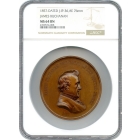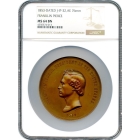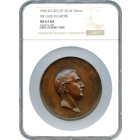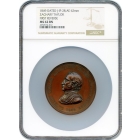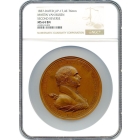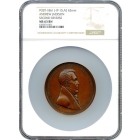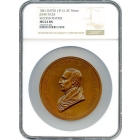Indian Peace Medal - 1885 Grover Cleveland, J-IP-46 AE Oval NGC MS64
Peace Medals were instrumental in building relationships with the various Indian Tribes. American Presidents (and their Colonial predecessors) used Indian Peace Medals as a way of placating various tribes and/or to build alliances with them. The recipients valued them highly, for they conferred a prestige that was recognized throughout the nation. The Bureau of Indian Affairs considered them crucial and the Presidents for whom they were issued also knew their importance. Many images from the "Old West" show Indians proudly wearing their Peace Medals (sometimes more than one). Generally, bronze medals were not used for presentation purposes, but in some cases, they were silver-plated and either given, sold, or traded away by unscrupulous individuals to unwitting recipients.
NGC total census of 6 oval medals. There are three certified finer - a MS64, MS65 and an outstanding MS67-!
Grover Cleveland Indian Peace Medals
There was a great delay in the creation of the Cleveland Indian Peace Medal. Over two years after Cleveland's inauguration, H.L. Muldrow, Acting Secretary of the Interior, wrote to the Secretary of the Treasury: "In pursuance of the practice of the Department in having Indian Peace Medals prepared, bearing the likeness of the respective Presidents of the United States stamped thereon, it is now desired to obtain such a medal bearing the likeness of President Cleveland, to be distributed to deserving Indians when occasion may require it." He requested that the Mint Director have a design created, with the reverse presenting "something allegorical, suggestive of the present condition of the Indian race," and also asked for an estimate of the price of those medals struck in "Silver, Bronze, Gold plate, Silver plate, Nickel plate and Brass."
The Mint in Philadelphia told the Interior Department that "pursuing our usual custom" the Cleveland Indian Peace Medal had previously been crafted and that copies of it were produced in bronze. Francis Paul Prucha writes, "The medal used the bust of Cleveland provided by the engraver Charles E. Barber for the presidential inaugural medal and the reverse from the Garfield and Arthur peace medals." The Mint Superintendent said that it could be struck in bronze for the Indian Office at fifty cents each and in silver for $6.00 each. However, there was no equipment available at the Mint to create brass or plated medals.
In April of 1887 the Interior Department ordered 10 silver and 30 bronze medals at a total price of $75.00, which was paid from the Indian Office's Contingent fund. About a month later, on May 24, 1887, the Interior Department received the medals and sent an invoice to the Indian Office for payment. William F. Vilas, Secretary of the Interior, presented silver and bronze medals to deserving Indians. It was in December of 1888 that he sent a silver Cleveland medal to Big Mane, a Brulé Sioux chief, "in recognition of his intelligence and excellent disposition," as well as 10 bronze medals to be presented by the chief, under the watchful eye of an Indian agent, to well-deserving Indians. The dies of this medal were put into use again in 1896 during Cleveland's second, non-consecutive term in office, when silver IPMs were produced on special occasions to be given to Indians.
Grover Cleveland and the Indians
It was in 1887 that Cleveland signed the Dawes Act, which enabled the president to slice Indian lands into individual allotments. This forced Indians into the ownership of private property. Those Indians who accepted allotments of 40 to 160 acres and lived separately from their tribes for 25 years would be given US citizenship. Under the Dawes Act, the remaining land would be considered "surplus" and then sold to non-Indians. When Cleveland first became president, around 260,000 Indians lived on 171 reservations of 134 million acres of land in 21 states. He supported the effort to assimilate the Indians into American society via education, private land ownership, and fatherly guidance from the government. The late 19th century saw conflicting opinions of how the Indians should be separated from Americans on reservations, while the other was for total integration into the mainstream of American life. Cleveland supported the acquisition of Indian land, however, he was dead set against illegal white settlements that provoked Indian violence. He signed a number of proclamations prohibiting non-Indian use of Indian land. In 1889 he signed the Indian Appropriation Act which officially opened "unassigned lands" in Oklahoma to white settlers under the provisions of the Homestead Act.
Cleveland, the only president to serve two non-consecutive terms, said, in his second inaugural address (March 1893): "Our relations with the Indians located within our borders impose upon us responsibilities we cannot escape. Every effort should be made to lead them, through the paths of civilization and education, to self-supporting and independent citizenship. ...they should be promptly defended against the cupidity of designing men and shielded from every influence or temptation that retards their advancement."
It was in March of 1893 that Congress authorized the Dawes Commission; it extended the allotment plan to the Five Civilized Tribes: Cherokee, Chickasaw, Choctaw, Creek, and Seminole. Henry Dawes led the commission, and it introduced citizenship documents called the Dawes Rolls, requiring Indians to enroll by claiming a single line of ancestry -- even if they were of a mixed heritage from various tribes. Some people had their ancestry taken away from them via the Dawes Roles. However, they are still used today to ascertain citizenship, or as a requirement for tribal membership, and are employed to determine blood-quantum status when issuing Certificates of Indian Blood.
Grover Cleveland Indian Peace Medals for Indians and collectors
Dated 1885, only 40 Cleveland medals were ordered to be given to Indians. According to a report in Numismatic News, a silver Cleveland IPM sold in a 2,844-lot exonumia mail-bid sale by Rich Hartzog in 2008. It fetched $6,510.00. An oval copper Cleveland Indian Peace Medal sold at Heritage Auctions in December of 2016. Graded nearly uncirculated and uncertified, it sold for $3,000.
| Grading Service | NGC |
|---|---|
| Year of Issue | 1885 |
| Grade | MS64 |
| Denom Type | U.S. Mint Medal |
| Numeric Denomination | Medal |
| Mint Location | Philadelphia |
| Designation | NONE |
| Circ/UnCirc | Uncirculated |
| Strike Type | Business |
| Holder Variety | Grover Cleveland: J-IP-46, AE, Oval |
| Grade Add On | NONE |
| Holder Type | N/A |


